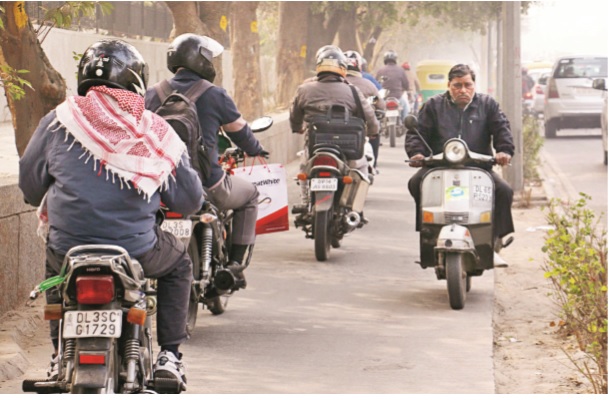Arvind Kejriwal should remember two elementary economic propositions when overhauling his odd-even scheme for cars. One, those who use public benefits (like roads) should pay levies to finance those benefits. Two, financial disincentives are better than physical bans and controls.
The odd-even scheme applies to all vehicles plying in Delhi, regardless of whether they are registered in Delhi or neighbouring states (like UP and Haryana). Why treat the two on par? Delhi’s congestion and pollution are worsened by commuters from outside. They use and congest Delhi’s facilities. But they do not pay car registration taxes, property taxes or other local taxes in Delhi: they pay these in Haryana or UP. The first step must be to tax outsiders, discouraging their entry. This will also raise much-needed revenue to improve Delhi’s transport infrastructure, further decongesting and de-polluting the city.
Singapore and London have successful, well-known congestion levies on vehicles entering the city centre. There is no clear-cut city centre in Delhi. Rather, Delhi state is the city centre of the National Capital Region (NCR). So, all outside vehicles entering Delhi state should pay for the congestion and pollution they cause.
Electoral politics makes it difficult to apply simple anti-congestion rules on all Delhi voters. Kejriwal has exempted several categories, notably two-wheelers, cars running on electricity or CNG, female-occupied cars, and so on. Studies show that two-wheelers cause serious pollution. Electric/CNG cars cause as much congestion as any others. But Kejriwal has provided widespread exemptions to reduce voter backlash.
However, if the odd-even scheme is imposed only on persons entering from outside, Kejriwal can tax all of them because they don’t vote in Delhi. Almost all exemptions can go, and polluting two-wheelers can be covered. That will be fairer, more comprehensive and more effective.
Next, consider the second proposition at the start of this column: financial disincentives are better than physical controls and bans. Let me illustrate with respect to imports. Import bans and physical controls encourage smuggling, misdeclaration, bribes, and other avoidance stratagems. Shifting from physical controls to import taxes can discourage imports without (or with much fewer) attendant problems.
Physical controls need staff and money to administer, and yield no revenue. But financial levies require less staff, and raise large revenues covering administrative costs and yielding a large surplus to finance fresh infrastructure. The congestion tax in London or Singapore is a financial, not physical disincentive, and so works well.
As CSE chief Sunita Narain says, Delhi’s odd-even scheme will cease to reduce congestion if made permanent. Citizens will start buying second cars, bogus number plates, paying bribes and using sundry other tricks. This will happen much less if the odd-even scheme is imposed only on vehicles entering from outside. Some permanent commuters may buy second cars, but not occasional visitors.
However, following our principles, a stiff entry tax will be better than a physical control like the odd-even scheme. An entry tax may entail hassles in operating toll-gates at every entry point. Both London and Singapore have evolved methods of electronic taxing, which collect revenue without delays or armies of inspectors.
In India, some combination of methods will be required. A start could be made with an odd-even rule for outsiders alone. This can be followed by setting up toll-booths at main entry points, and later at all points. Electronic taxation can come in phases.
Another key financial disincentive must be a big jump in parking charges, which today can be Rs 10-30 per day, or even zero. This entails an enormous hidden subsidy for vehicle use and congestion. The value of parking space in city centres is enormous. A parked car occupies as much space as two or three desks: you could start a small office in that much space. If you don’t rent space to offices so cheaply, why to vehicles?
In many countries, parking charges are high enough to fetch garage owners as much as office rentals. This encourages the building of multi-storeyed parking lots as a commercial business. In New York you can pay up to Rs 4,000 per day for parking, and up to Rs 2,000 per hour. Delhi needs to charge at least Rs 70-100 per hour for cars, and maybe one-third as much for two-wheelers. That will reduce congestion significantly. The increase can be phased over a few years to reduce voter resistance, but must be a top priority.
Reducing cars on the road should go hand in hand with a massive increase in public transport. That needs massive revenue. As a populist, Kejriwal may prefer physical control to taxes. But that won’t finance more buses, and will encourage the bribery and law-breaking he was elected to stop. Go the tax route, please.



What’s to stop Gurgaon & Noida from then taxing vehicles registered in Delhi?
This won’t work. Large number of people travel to Delhi everyday for work. This will lead to valid outcry in respective states. Other leaders will impose tit for tat taxes on Delhi people. Kejriwal will end up getting blamed for everything.
If more tax is needed Kejriwal should be honest with people and communicate clearly. That is more likely to work
More people drive from Delhi into Gurgaon than vice versa. You just have to drive on the NH8 expressway at around 8.30am and 6pm to see this for yourself. In the morning the traffic jams are on the Gurgaon bound carriageway, and in the evenings, it is on the Delhi bound side.
So actually, it should be Gurgaon charging the Delhi vehicles which contribute hugely to pollution and congestion within Gurgaon, without paying any road tax to the Haryana kitty.